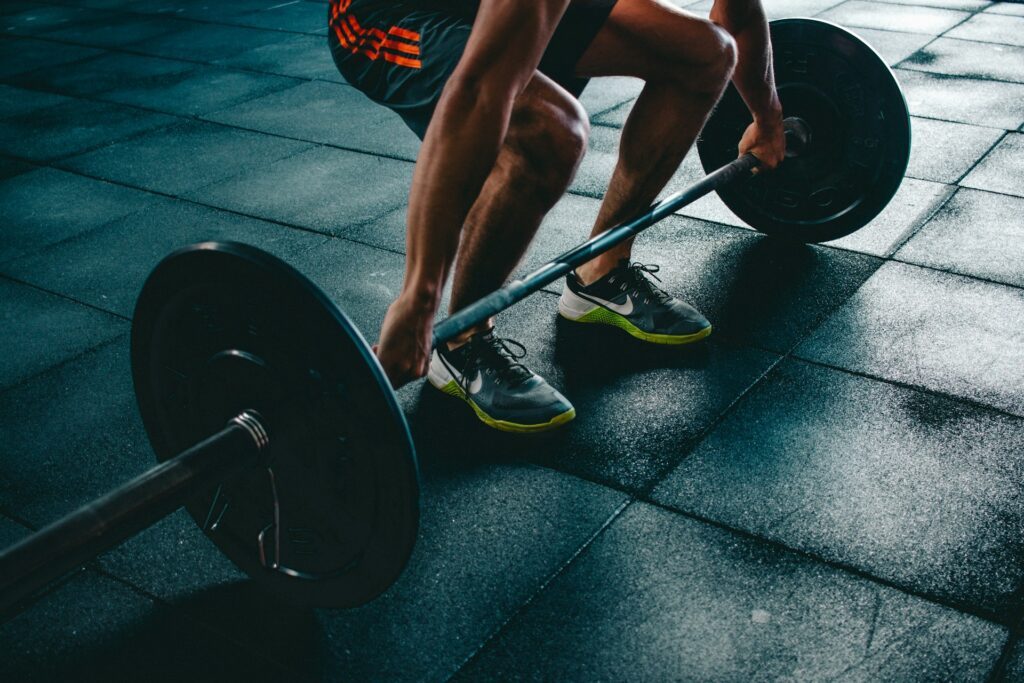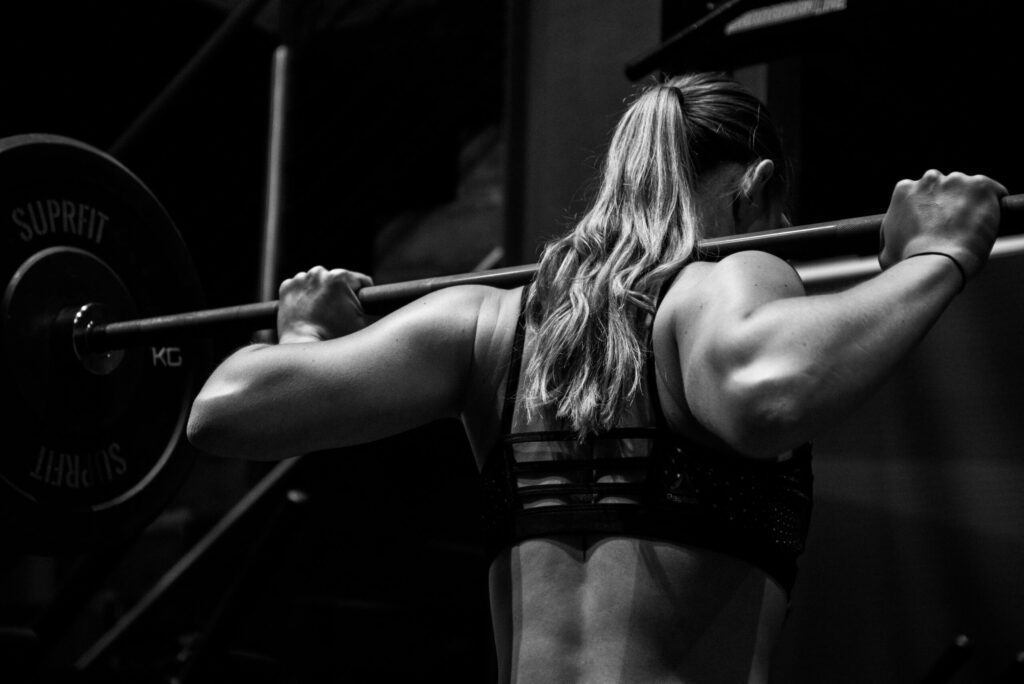Training during a fat loss phase is a large area of contention within the fitness industry. Given that body composition improvements are arguably the leading goal of your average gym goer and that same gym goer would likely rather train hard than diet hard, this often leads to questions such as:
“What’s the best type of training for fat loss?”
“What are the best exercises for fat loss”
And so on.
This article aims to give the reader an overview of how to best apply training (resistance and cardio) as it relates to a fat loss phase in order to optimise body composition.
Before we begin, we will outline the basics of fat loss.
The Physiology Of Fat Loss
The fundamental concept to understand when it comes to fat loss is energy balance. As humans we have energy that comes into the body via the food and drink we consume. We then use this energy to function. Within the body we can then have 3 different conditions. These conditions can be summed up via the following equations:
Energy In > Energy Out = Weight gain.
Energy In = Energy Out = Weight Maintenance.
Energy In < Energy Out = Fat Loss
Zoning in on the last equation, we need to consume less energy than we expend and this is what we refer to as an energy deficit. Our body will always prefer to sit at its current maintenance and so when the energy coming into the body doesn’t match the energy going out, we have to find energy from another source. When this occurs, the body amongst other changes will begin to mobilise stored fat and break it down to be used for energy and this is how we lose fat.
In order to tip the balance of this equation in favour of fat loss we need to understand what each side consists of.
The energy in side is fairly straight forward. It’s simply the food and drink we consume. The energy out, side of the equation consists of the following:
-
Basal Metabolic Rate (BMR): Amount of energy needed for the body to perform vital functions at complete rest. Energy that “keeps the lights on”.
-
Non Exercise Activity Thermogenesis (NEAT): This is energy used for normal non incidental day to day activities. Walking to work or taking the stairs for example.
-
Exercise Activity (EA): Energy used for purposeful exercise.
-
Thermic Effect of Food (TEF): This is the energy needed for the digestion of food.
Combined, these all comprise of our daily total energy expenditure (TDEE).
Anyone that has spent a long time in a deficit or lost significant amounts of fat knows that it’s not as simple as just dropping calories once and breezing through. Our body is adapted for survival and when we create a deficit our body naturally moves to mitigate this deficit and bring the body back to an equal energy balance. Specifically, it does this by manipulating the 4 components of energy output. These 4 factors will see a down regulation in an attempt to bridge the energy gap created and to ultimately restore energy balance.
BMR reductions during a fat loss phase are largely a result of a down regulation in the secretion of Thyroid hormones. Put simply, one of the main roles of thyroid hormones is to set the base metabolic rate for all cells in the body so it makes sense that if we see a decline in its secretion, BMR would also down regulate. Depending on the length and severity of the diet we may see entire systems become affected. A classic example is when females lose their menstrual cycle from long periods of dieting as energy is pulled away from non essential systems and redirected simply to survival.
As we lose fat we also become smaller, meaning we cost less to function i.e A 90kg person likely has a higher BMR than an 80kg person simply because there is more of them. Unfortunately for BMR there is not much we can do in order to preserve it as thyroid function is largely dictated by energy intake and if you’re losing fat, bodyweight reductions will obviously occur.
NEAT is a key player for energy expenditure. Less energy coming in will cause the body to reduce energy going out from various non-purposeful activity. You’ll inherently begin to fidget less, you’ll sit every chance you get, take the elevator instead of stairs, some people even speak slower. These changes often creep up on you without even noticing and this can lead to frustrating stalls in fat loss.
EA will be addressed in the cardio section below but essentially it’s another ‘tool’ we have to assist in creating the required deficit. Resistance training also falls within this category but as you will read, our opinion is that energy expenditure is not the primary goal of resistance training as it relates to a fat loss phase.
The amount of food we eat is going to be significantly less during a diet and this will in turn cause our TEF to be lowered. We can do our best to offset this as much as possible by consuming a diet high in protein with sufficient levels of fibre (vegetable and whole grains) as these along with total food intake are the main contributors to TEF.
Training For Fat Loss
To best dissect training during a fat loss phase we believe it should be split into two categories. These categories being resistance training and cardio and each coming with their own objectives.
Resistance training as it relates to fat loss should be designed with the goal in mind to maximise muscle retention. When we refer to improving body composition the aim is for specifically fat loss, not weight loss. The difference is that weight loss simply refers to a total loss in body mass, no matter where it comes from. This means weight loss doesn’t account for or put in place measures to prevent muscle loss and this is something we want to avoid.
Cardio as it relates to fat loss should be designed to:
-
Help maintain a baseline energy expenditure in order to allow the deficit created by decreased food intake to have an effect or,
-
To work synonymously with decreased food intake to increase the energy deficit.
Resistance Training & Fat Loss
In a fat loss phase, obviously fat loss is our primary goal. But in order to achieve the best body composition possible we want to hold onto our muscle mass, hence why muscle retention becomes a very important secondary goal. When resistance training is combined with a calorie surplus and a sufficient protein intake, we have the 3 key players for effective muscle growth. During a fat loss phase we lose that calorie surplus and therefore expecting significant muscle growth should be out of the question. We can however turn our attention to muscle retention and this is accomplished through resistance training and sufficient protein intakes.
The question is, how do we best organise our resistance training for fat loss?
‘What ever built muscle, keeps muscle’
That’s right! The best place to start is to change nothing at all. The same training principles that helped you build muscle will help you retain it in a deficit. Obviously there are some considerations we need to take into account mainly around fatigue management but if you want to view resistance training in its simplest terms, the least you change the better. What does this likely look like/ what are the current recommendations? In general you’ll be:
-
Volume: 10-20 working sets per muscle group per week
-
Frequency: Training each muscle group 2-4 times per week
-
Intensity: Working with an absolute intensity between 60-85% of 1RM or relative intensity/RIR of 1-4.
Structuring your training around these 3 parameters and progressively overload as adaptions allow and you’re 90% of the way to a productive training program regardless of your net energy position.
In saying all that, there are some considerations that you may need to take into account as a fat loss phase will clearly have it’s own unique set of obstacles to work through. The above is a good starting point for most, but it doesn’t mean there can’t be any flexibility within that framework to better suit a fat loss phase.
Exercise Selection
Fatigue management should be always be an important consideration in your training but during a fat loss phase you have conditions that will likely make it somewhat harder to navigate. On one hand we ideally want to maintain and potentially progress our training volume in order to maintain muscle mass but we also need to account for the decrease in energy intake compared to what we are accustom to. Whilst fatigue accumulation should be expected and is a necessary bi product of training and dieting, too much can lead to things like injury, poor training and low compliance.
Is maintaining our training volumes optimal? Yes, it likely would be we must take into account our limited recuperative abilities. Given training with similar volumes will probably give us the best chance to retain muscle, how can we afford to do it without grossly ignoring the concept of fatigue management. One way we can do this is exercise selection.
When selecting exercises we can look to ones that are highly stimulative of the target muscle but don’t generate the systemic fatigue it’s counterparts do. Muscles respond to stimulus not exercises. Your quads don’t know if they are squatting, leg pressing, lunging or doing leg extensions but they are getting a stimulus from all these exercises.
This is where we come to the stimulus to fatigue ratio which was developed by Mike Istratel of Renaissance Periodisation.
The stimulus to fatigue ratio is the amount of stimulus an exercise provides to the intended muscle in relation to the amount of fatigue it brings to your body. Ideally we move to exercises with a high stimulus and low fatigue cost during a fat loss phase. To determine if an exercise is stimulating you are looking at the following metrics
-
Pump
-
Mind muscle connection
-
Local soreness
If you get a really good pump, have a great mind muscle connection during the movement and have a degree of soreness in the following days then it’s likely a stimulating exercise. You want to try and find exercises that tick the above but don’t induce heaps of fatigue. For example, a deadlift is a common exercise people use to target glutes and hamstrings. Whilst is does provide a good stimulus on these muscles, the systemic fatigue it induces is huge and this may affect the productiveness of subsequent exercises, workouts and your recuperative ability while energy availability is limited. Another proposed exercise to hit your hamstrings and glutes would be RDL’s. The increase in hip flexion moves the glutes and hamstring through a greater ROM with a lighter load, a 2 fold benefit. The fatigue cost of an RDL is much lower than a conventional deadlift for comparatively similar stimulation of target muscles. In its full use, the stimulus to fatigue ratio can be determined numerically (hence ratio) but we believe you can still develop a good understanding of appropriate exercises without this just based off training experience.
Re Organise Your Training Split
From a fatigue management stand point, reorganising your training split and increasing the frequency you train muscle groups may prove beneficial especially in the back end of a fat loss phase. Increasing the frequency doesn’t necessarily have to correlate to more volume. If you take 15 sets weekly sets of quads and divide them into 1 session with 8 sets and 1 session with 7 sets VS 3 sessions with 5 sets, volume remains the same but session frequency increases in the second scenario.
How is this potentially beneficial for training during a fat loss phase?
With the increase in fatigue associated with a fat loss phase we can potentially avoid a drop off in weekly set quality if training frequency for muscle groups increases. Let’s go back to our quads example where you have a total of 15 working sets over the week. Whilst in a surplus your training split may be lower, push, pull, lower and upper. The quad exercises in your first leg day are 4 sets of BB back squat, 3 sets of leg press and 2 sets of leg extension. The second lower day has 3 sets of hack squat and 3 sets of walking lunges. Remember that these exercises will be combined with other glute/ham dominant exercises so your typical lower body sessions likely has 5-8 exercises. In a surplus this is fine. Deep into fat loss phase a leg session starts to become quite a daunting prospect and it’s likely that session quality will begin to tail off as you get further and further into the diet. Instead of 15 good quality quad sets, we may get 10 quality sets and then the other 5 we just float through. Obviously not ideal but we may be able to combat this by re organising training. For example, in the last training block of our fat loss phase where fatigue is at its highest and motivation lowest we might train with a split that looks like full body, full body, full body, full body and upper. In 3 of those full body days we train quads, allocating 5 sets to each session. This is much less daunting than a thought of having to do 8 sets of quads plus our glute and hamstring work in a full lower body day. 5 sets of quads and likely 1 posterior exercise and it’s over for that session. After that you can rest, eat and get ready to go again. Now we have a situation where we are giving ourselves the best chance of 15 quality sets over the week.
It should be noted that some research suggests that reaching around 8 sets and above per session per muscle group is needed for to achieve optimal muscle stimulation within a single session. The reality is that appropriate levels of stimulation can likely be achieved either side of this figure in a range. Therefore just because you don’t reach 8 sets for a particular muscle group it doesn’t mean growth hasn’t been stimulated, there might just be slightly less of it and remember we are likely training that muscle again in quick succession. For example, dropping to 4 hard working sets per session for a muscle group should still be stimulating and allow for this growth.
Fat Loss Workouts and Best Exercises For Fat Loss
Above we stated that:
“Resistance training as it relates to fat loss should be designed with the goal in mind to maintain muscle mass.”
This means that creating a calorie deficit with resistance training should NOT be at the forefront of your mind. Often we see people who are looking to improve body composition switch from a well-designed resistance training program into what something that resembles F45. The training focus switches from muscle stimulation to:
Whilst there is nothing wrong with this style of training (all forms of exercises are great), we can all agree that for the purpose of hypertrophy and muscle retention it’s not ideal. Muscle hypertrophy has no correlation with how exhausted you can make yourself.
With that being said, the best resistance training for fat loss is the one that best helps you retain muscle mass. Leave the energy deficit to food and a little cardio.
Cardio
Again, as we have stated earlier,
Cardio as it relates to fat loss should be designed to:
-
Help maintain a baseline energy expenditure in order to allow the deficit created by decreased food intake to have an effect or,
-
To work synonymously with decreased food intake to increase the energy deficit.
Unlike resistance training, cardio’s main role is to contribute to the energy deficit. It should be viewed as a tool to at the very least uphold our baseline starting energy expenditure. From there to assist in creating a further deficit where reductions in food intake are already in place. All of this whilst again taking into consideration its role in fatigue.
Cardio Should Work To Compliment Decreased Food Intake Not Replace It
If you try to train or exercise your way to fat loss then you’re in for an unpleasant time. There are generally two ways in which you’ll create your starting energy deficit for a fat loss phase.
After the first initial reduction, the relationship for decreases in food intake or increases in output will be dictated by the individual’s circumstances. Never in my coaching career have I attempted to get someone lean by only increasing energy output without considering food intake. There are two reasons for this. Firstly, creating a deficit through food is much more accurate and measurable than measuring energy expenditure from exercise. Whilst it’s not perfect as we have to account for human error, it’s a hell of a lot more accurate and practical than a treadmill monitor. Second, cardio doesn’t burn as many calories as we might think for the amount of effort we put in. Subjectively we can feel like it’s been a very challenging session but the reality is the number of calories used will be far less than what we’d hoped for. This means that trying to simply train your way to fat loss is a very inefficient way to go about it. You will end up with the required cardio being far beyond what’s maintainable due to time restraints and fatigue accumulation.
So how do we use cardio? If all we do during a fat loss phase is reduce our food intake, there is the potential to be eating very little quite soon. Cardio helps prevent this or at the very least, delay it. Everyone will stall at some stage(s) during their fat loss phase. Whilst we could take 200 calories out straight away, another viable option would be to drop by 100 calories and add 40 mins of cardio into the week. Anyone that has seriously dieted knows the difference 100 calories can make and would happily add 40 minutes of cardio to their week to keep those 100 calories (Note: If can’t add more cardio because you’re at a point where it’s already too high for further increases and calories very low then it’s time to think about ending the fat loss phase).
We can also take a step back and look at cardio as a means to uphold baseline output. Remember above we mentioned that when we create an energy deficit your body will spring into action in an attempt to bridge that gap. One way it does this is through attempting to reduce your NEAT. Essentially you will begin to move less both consciously and subconsciously and this can potentially negate the deficit initially created by food. NEAT is often simply measured by daily steps. So if your coach programs you for a 20 min walk each day in the aim to hit a desired step count, yes it is cardio but the aim is to offset reductions in NEAT from you moving less in other parts of your day.
Type Of Cardio
“Which type of cardio is best for fat loss?”
In general we have two main contenders, these being
HIIT is characterised by short bursts of maximal effort followed by rest periods. LISS is characterised by longer single bouts of low intensity exercise like walking. When considering which one to choose you need to make a decision based on recovery, enjoyment, energy levels and time.
All training during a fat loss phase will require a fine balancing act. As we have said fatigue is expected and a necessary bi product but if not managed it will commonly result in non-compliance. If time is a not an issue then from experience LIIS would be generally be our recommendation when it comes to cardio. When calorie expenditure is equated, the recovery cost and perception of fatigue will likely be higher from a bout of HIIT training than LISS. Although it requires a longer duration it doesn’t appear to be accompanied with the same fatigue. Further the more intense the cardio, the higher the likelihood we will see a drop in activity for the remainder of the day. For example, you’re much more likely to want to chill out on the coach all day after a 20 minute all out HIIT session as opposed to a 60 minute brisk walk.
As we just touched on, time is another important factor for a cardio. Some people simply won’t have 45 – 60 minutes (sometimes more) in their day on top of everything else to dedicate to LISS. This means a HIIT session or a combination of both will need to suffice.
Arguably the most important is which form you enjoy the most? Fat loss success is largely dictated by our adherence and adherence is made easier if we enjoy what we are doing.
If you take all the above factors into consideration as it relates to choosing a cardio modality then you are well on your way to making a well informed decision.
Conclusion
There you have it! Hopefully this article has answered all your training related questions when it comes to fat loss. In summary
-
Resistance training should have the goal of retaining muscle mass during fat loss and therefore it should follow the same principles as if you were in a surplus. What builds muscle, keeps muscle.
-
Exercise selection and smart re organisation of our training week can help accommodate for the increased fatigue that comes with being in an energy deficit, while still getting appropriate stimulation.
-
Cardio should have the goal of assisting in creating the energy deficit with decreasing energy intake being the primary method. Cardio prescription can also be a means of simply accounting for natural decreases in daily activity.
-
LISS and HIIT are both common cardio modalities. Time allowance, fatigue and enjoyment must all be considered when making a decision on which to do.










